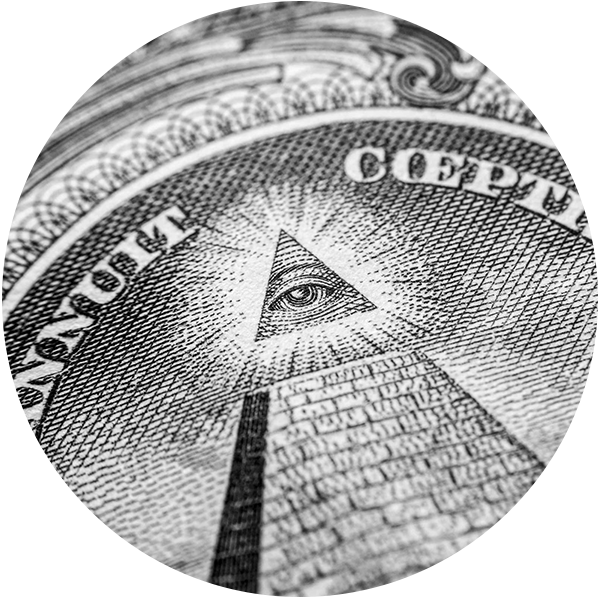The History of Freemasonry In Brief

Freemasonry is an “esoteric discipline”, in the sense that some aspects of its internal activity are not in the public domain, but covered by confidentiality. The members of Freemasonry are called “freemasons” – “franc-maçons” in French – “framassoni” or “liberi muratori” in Italian. The name comes from the alleged offspring of the Company of the Free Masons – an association of operative masons that used to refer to the legend of Hiram, architect of the Temple of Solomon. Freemasonry was born as an association of mutual aid and moral improvement among craftsmen masons, which later adopted the current speculative guise, turning into an initiatory type of brotherhood characterized by secret rituals, with a worldwide organization.
Its affiliates share the same ideals of both moral and metaphysical nature and the common belief in a Supreme Being, called the Grand Architect of the Universe.
It is not easy to reconstruct, in historically incontrovertible terms, the birth of Freemasonry as a concretely documentable phenomenon and for this reason someone has come to the conclusion that its true origins are lost in history. The roots of Freemasonry are traditionally traced – by its members – to the construction of Solomon’s Temple (the Inner Temple or Esoteric Temple) and to the legend of Hiram Abiff. According to the Bible, Hiram was sent by the king of Tire to Solomon to help him build the Temple. In the masonic legend, the brilliant craftsman instead becomes the architect of the Temple, in charge of the direction of all the works and all the workers. The story has its own mystical interpretation key and refers to the concepts of Perfection, the aim of mystical research, and refers to the Great Work (the work of the Grand Architect who created the Universe), through whose understanding the entrance of the sacred into the profane takes place. Symbolic Freemasonry is based on this mystical vision and therefore it would exclusively deal with a spiritual path.
A historical source supported by some documentation – not yet historically proven – asserts the antiquity of Freemasonry based on the Regius Manuscript or Poema Regius (also called Halliwell Manuscript, from the name of the one who discovered it in 1840), datable to 1390, which refers to many phrases and concepts similar to those found in Freemasonry: this manuscript consists of 794 verses in rhyme and in medieval English. According to this legendary narrative, Freemasonry is geometry, art or science of excellence applied to masonry; the first teacher was Euclid and the homeland was Egypt, from which he arrived in England at the time of King Atelstano, who gave Freemasonry its first constitutions.
The difficulties in establishing a precise dating on the birth of the Masonic phenomenon are to a large extent a consequence of the secrecy that – especially in the past – enveloped “the Order”: in turn, the fact that Freemasonry has often provided a refuge for the unorthodox and their sympathizers during a time when certain activities could end in death, can be at the origin of the traditions of secret meetings and secret signs and handshakes.
The foundation of the Grand Lodge of London, subsequently renamed Grand Lodge of England, formally or conventionally marked the act of transition from the ancient Craft or operating Masonry to the modern or speculative one: on the 24th June 1717, four London lodges decided to give themselves a new centralized organization, to which they gave the name of The Grand Lodge of London. On January 14, 1723, thanks to the work of the presbyterian pastor James Anderson, the lodges adopted the so-called Anderson’s Constitutions.
Famous is Title I, concerning God and religion:
“A Mason is required, by his condition, to obey the moral law; and if he rightly intends the Art, he will never be a stupid atheist or an irreligious libertine.”
Although in ancient times the Masons were obliged in every country to be of the religion of their country or nation, whatever it may be, today it is considered more convenient to oblige them only to that religion in which all men agree, leaving them their particular opinions, that is, to be good and loyal men or men of honor and honesty, whatever are the denominations or confessions that serve to distinguish them, so that Freemasonry becomes the Centre of Union and the mean to establish a sincere friendship between people who would have remained strangers in perpetuity.
In a country like England, for almost two centuries upset by political, social and dynastic upheavals marked by religious divisions, the self-definition of Freemasonry as a “centre of union” among men, on the sole basis of their moral qualities and of a not precisely qualified religiosity, it constituted a clear leap forward, semi-utopian and revolutionary.
The eighteenth century saw a constant spread of Freemasonry in the old and the new continent, according to the expansion lines of the British Empire, its maritime trade and colonization.
The military lodges, constituted within the units of the English army, and frequently transferred from one to another part of the Empire, were a very effective instrument of this propagation, materialized in the foundation of lodges subsequently regularized by the granting of warrants issued by one or the other English Grand Lodge – or from the Grand Lodges of Scotland and Ireland.
The development of the new Freemasonry outside Great Britain and its dominions was very rapid:
• in 1728 a lodge was founded in Madrid and one in Gibraltar;
• in 1731 the G. L. of London appointed a provincial Grand Master for Russia;
• still in 1731 an English lodge was founded in Firenze;
• in 1733 the first American Provincial Grand Lodge was born in Boston;
• in 1734 the Dutch Freemasons elected a Grand Master for the United Provinces;
• in 1735 lodges were established in Lisbon, Rome, Milan, Verona, Padua, Vicenza, Venice, Naples, Stockholm;
• in 1736 a lodge of Genova was founded;
• in 1737 a lodge was established in Hamburg.
In Italy the first lodge was founded in Florence in 1731: around the initial nucleus, consisting of English noblemen, numerous Florentine nobles and intellectuals gathered. The persecutory effects of the papal bull “In eminenti”, published on April 28, 1738, affected that lodge, inaugurating a long series of excommunications and sentences. Still in the Grand Duchy of Tuscany, in Livorno, four lodges were established: two in the years 1763 and 1765 which obtained a warrant from the Grand Lodge of England of the Antients, and two others in 1771, chartered by the Grand Lodge of England of the Moderns.
The Masonic phenomenon then arrived in Rome, with alternate success: in 1735 some English gentlemen gave birth to a “Jacobite” Lodge, which remained active until 1737, when it had to be dissolved by order of the government of the State of the Church. But, respectively in 1776 and 1787, two lodges were founded there, both following the Scottish Rite. On May 27, 1789 the Count of Cagliostro attempted to establish a lodge based on his “Egyptian rite”, but was arrested, and took to trial by the Holy Office, which in April 1791 sentenced him to death as a “formal heretic, magician and free mason “, penalty then commuted in life sentence.
A series of initiatives, taken almost simultaneously by the governments of the various Italian states, inaugurated a period of repression of the masonic phenomenon.
In the Kingdom of Sardinia, on the 10th June 1814, King Vittorio Emanuele I issued an edict with which he reiterated “the prohibition of secret congregations and meetings, whatever their denomination, and especially those of the so-called Free Masons already forbidden with the Royal Edict of May 20, 1794 “. A similar decree issued on the 26th August 1814 in the Lombardo Veneto region, forbade “secret orders, meetings, guilds and secret brotherhoods, as would be the lodges of so-called Free Masons and other similar societies”, while Pope Pius VII (15th August 1814) issued an edict which, referring to the encyclicals of Clement XII and Benedict XIV, forbade the “aggregations of the aforementioned Freemasons, and others like them”, and in Naples King Ferdinand IV Borbone (8th August 1816) forbade “the secret associations which constitute any kind of sect, whatever is their denomination, the object and the number of their components”.
However, the Italian masons resisted and even worked to strengthen and organize their activity, until they re-emerged significantly in the second half of the nineteenth century.
On October 8, 1859, in Turin, seven “brothers” formed a new Lodge, called “Ausonia” from the ancient poetic name of Italy: from this seed on December 20, 1859, also in Turin, an organisation was established that explicitly aspired to become a national Grand Lodge and named itself Grande Oriente Italiano.
The intent of being a national organisation materialized with the first constituent assembly of the Grande Oriente Italiano., which was held in Turin from the 26th December 1861 to the 1st January 1862 under the presidency of Bro. Felice Govean, acting as Grand Master, and with the presence of representatives of twenty-eight Lodges: Giuseppe Garibaldi was acknowledged as “the most prominent Italian Freemason”.
Since 1864 various Masonic Orders, either Grand Lodges or Grand Orients, flourished on the Italian soil, such as the Grand Orient of Naples, the Grand Orient of Turin and the Grand Oriente of Palermo. In a constituent meeting held in Florence, between the 21st and the 24th May, in prevision of the transfer of the capital of the new Kingdom of Italy to that city, the three Grand Orients merged into the Grande Oriente d’Italia, headed by Giuseppe Garibaldi.
In 1884 the encyclical Humanum Genus of Pope Leone XIII, probably marked the highest moment of clash between the Catholic Church and Freemasonry: the pontifical document, in addition to charging Freemasonry with “atrocious vendettas … towards who is believed guilty of having betrayed the secret and disobeyed the command, and this with so much audacity and dexterity, that often the henchman escapes from the searches and the blows of the justice “, (he) sustained that the objective of the Masons was to” destroy from top to bottom all the religious and social discipline that (it) was born from the Christian institutions, and replace it with a new one, modeled on their ideas, and whose fundamental principles and laws are drawn from naturalism “.
In that climate, Bro. Adriano Lemmi was elected Grand Master (January 17, 1885). He worked to enroll representatives of the political and cultural world in the lodges, among those Giovanni Bovio, Giosuè Carducci, Agostino Bertani, Giuseppe Zanardelli.
On June 6, 1889, the monument to Giordano Bruno, by the sculptor and future Grand Master Ettore Ferrari, was inaugurated in Campo dei Fiori in Rome: the official Orator was the philosopher Giovanni Bovio; in 1895 Ernesto Nathan, then elected mayor of Rome, became Grand Master.
On June 24, 1908, a split occurred that hit the Grand Orient of Italy. That split gave birth to a new Masonic branch that was later called “Piazza del Gesù” from the place were the headquarter sat in Rome. In February 1911, after a long negotiation, the Grand Orient of Italy acquired the prestigious Palazzo Giustiniani in Rome, where it established its headquarters and after which the Order will be named “of Palazzo Giustiniani“.
On May 19, 1925 the Italian Parliament passed the draft law on the discipline of associations, presented by Benito Mussolini and aimed primarily at the dissolution of Freemasonry.
Even before its dissolution, the Grand Orient of Italy was on friendly terms with the Grand Lodge of France and in Paris, in year 1913, some Italian Brethren established the Italia Lodge no. 450. On May 28, 1930 the exiles founded the Italia Nuova Lodge n. 609, many members of which gave a notable contribution to the republican cause in the Spanish civil war, which was attended by nine members of the lodge, among which Randolfo Pacciardi and Francesco Fausto Nitti took part.
On January 12, 1930, Eugenio Chiesa was elected Grand Master of the Grand Orient of Italy in exile, which recognized the Italian lodges established abroad (Egypt, Tunisia, Argentina, etc.) and formerly under the jurisdiction of the Order of Palazzo Giustiniani.
On July 10th 1944 the “Committee of the Grand Masters“, formed by Umberto Cipollone, Guido Laj and Gaetano Varcasia, issued the communicate no. 1 to the “Dearest Worshipful Brethren, and to all Brethren of Italy“: the Committee considered itself the direct heir of Domizio Torrigiani and Ettore Ferrari, former Grand Masters, and on the eve of the institutional referendum of June 2, 1946, the Grand Orient stated: “We can neither wish nor do anything other than remind the Brethren of the need to uphold the principles we inherited from Mazzini, without imposing anything: in the temple of free thought coercions are not admitted. May the Brethren judge, going back to the history of Italy, particularly that of the last twenty years, which of the institutional forms is best suited to maintain precisely that temple of Freemasonry of which we are the workers and from this examination draw inspiration “.
From the ashes of Fascism, the Italian Freemasonry rose again, following two paths, one traced by the Grand Orient of Palazzo Giustiniani and the other by the Grand Lodge of Piazza del Gesù, the latter by the initiative of Raoul Palermi.
Because of the so-called “P2 scandal“, the simplistic equation “Masonry equal criminal organization” has crept into the collective imagination, going far beyond the objective conclusions reached by the judiciary power and the parliamentary investigating Commission itself. The latter, in its conclusions, had, among other things, ascertained that:
- “one cannot fail to recognize how Licio Gelli appears, from every point of view, as a completely atypical Freemason: he does not present himself as the natural and emblematic exponent of an organization whose cause he married with convinced adhesion, informing his actions, although distorted and censurable, for the ultimate purpose of the greater glory of the family; Licio Gelli, in other words, does not seem under any aspect, in his contrasted Masonic life, a new Adriano Lemmi, but rather an alien member of the community, like injected from the outside, with which he establishes a relationship of continuous, supervised instrumentalization “.
- “we can therefore affirm that all the elements at our disposal lead us to believe that the presence of Gelli in the community of Palazzo Giustiniani appears as that of an element inserted in it according to a precise infiltration strategy, which seems to have raised in its initial moment (not a few) perplexity and resistance in the receiving organism, which were probably overcome only thanks to the interest of the heads of the institution which, this is certain, since then appear in an intrinsic and unusual relationship of solidarity with the new adept ” .
The fact is that on the 31st October 1981, seven months after the discovery of the famous P2 lists and the following scandal, the Central Court of the Grand Oriente of Italy chaired by the new Grand Master Armando Corona, expelled Gelli from the Masonic Order; as a matter of fact, the ” Propaganda Lodge no. 2″ had alredy officially suspended its activity within the Order in 1976 and since then it no longer acted within the official Masonic institutions.
Since then, the Italian Freemasonry, despite the “disinformation” and the denigration campaigns founded “on the suspicion of what is not known”, continues its journey according to the heritage of 1717 and the teachings of the Constitutions of Anderson.

 IT
IT

